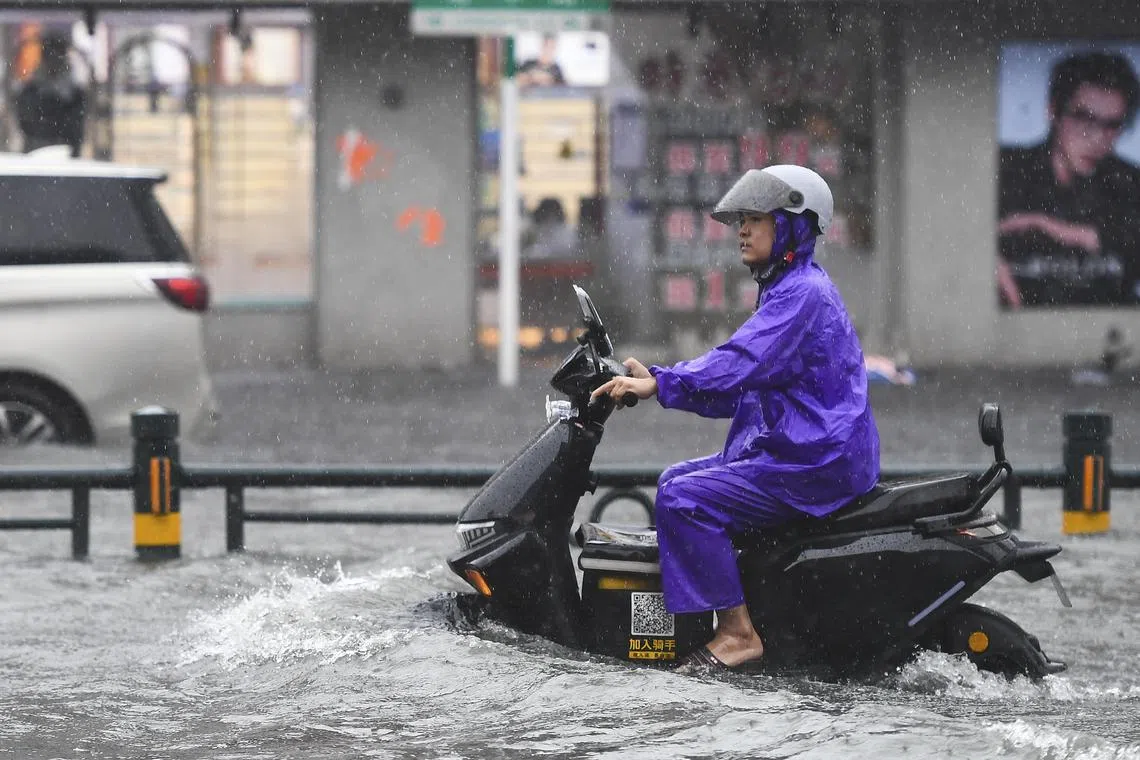Storms dump nearly a year of rain in northern China, 19,000 evacuated
Sign up now: Get ST's newsletters delivered to your inbox

The intensifying rainfall forms part of the broader pattern of extreme weather across China due to the East Asian monsoon, which has caused disruptions in the world’s second-largest economy.
PHOTO: EPA
Follow topic:
BEIJING - Storms in northern China have poured nearly a year’s rainfall on Baoding, an industrial city on the doorstep of the capital Beijing, forcing more than 19,000 people out of their homes as streets began to go under water and roads were being cut off.
As much as 448.7mm of rain fell in Yi, an area in western Baoding, in the 24 hours to early morning of July 25, triggering flash floods, causing power outages in some villages and damaging bridges and roads, according to state broadcaster CCTV.
The rainfall reset records at a number of weather stations in Hebei province, which Baoding is part of.
Official records show that annual rainfall in Baoding averaged above 500mm.
There were no immediate reports of casualties, any people missing or damage in state media.
A total of 19,453 people from 6,171 households were evacuated, the China Meteorological Administration (CMA) said in a social media post.
The forecaster did not mention where the residents were moved to but shared a short clip showing two policemen in neon rain jackets boot-deep on a waterlogged street as the rain poured at night.
CMA compared the amount of precipitation to the exceptional rainfall brought by a powerful typhoon in 2023, which inundated the capital Beijing with rains unseen since records began 140 years ago.
Baoding’s Zhuozhou, which suffered devastating floods in those rains two years ago, saw access to several bridges and roads cut off after the storms unleashed more than 190mm of rain by the morning of July 25.
Northern China has witnessed record-breaking rainfall in recent years, exposing densely populated cities including Beijing to flood risks.
Some scientists link the higher rainfall in China’s usually arid north to global warming.
In response to flood disasters in Hebei and also in several places in the north-western province of Shaanxi, the Chinese government on July 25 allocated 23,000 items for disaster relief, including emergency kits and blankets, to support local authorities.
Hebei recorded 640.3mm in annual rainfall in 2024, 26.6 per cent more than a decades-long average, according to CMA’s 2024 climate bulletin on the province.
The report said Hebei has been recording consecutive above-average annual precipitation since 2020.
In the summer of 2024, Baoding, together with neighbouring cities Zhangjiakou, Langfang, Xiongan and Cangzhou had 40 per cent more than the usual seasonal precipitation, with some localised areas within Baoding recording 80 per cent more rains, the report showed.
The intensifying rainfall forms part of the broader pattern of extreme weather across China due to the East Asian monsoon, which has caused disruptions in the world’s second-largest economy.
Chinese authorities are watchful of extreme rainfall and severe flooding as they challenge China’s ageing flood defences, threaten to displace millions and wreak havoc on a US$2.8 trillion (S$3.59 trillion) agricultural sector.
Baoding maintained a red alert for heavy rains on the morning of July 25, while Hebei upgraded its emergency response preparedness.
About 160km from Baoding, Beijing was not spared the impact.
Rains were forecast to intensify, potentially accumulating to more than 50mm over a six-hour period from the afternoon of July 25 till the morning of July 26 in a number of districts, state broadcaster CCTV said.
The capital is expected to see the heaviest rainfall since its flooding season began, potentially triggering flash floods, debris rushing down mountains, landslides and other secondary disasters, CCTV reported.
Beijing later on July 25 issued flash flood alerts for four of its 16 districts, warning of a rapid rise in stormwater, especially in the capital’s mountainous north and west through the morning of July 26.
Elsewhere in the country’s north, heavy rains disrupted railway service in Inner Mongolia as authorities suspended several passenger trains passing through high-risk areas from July 25 to 29. REUTERS

